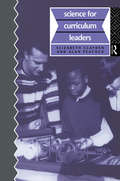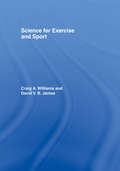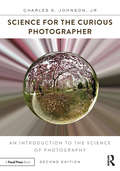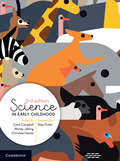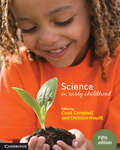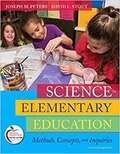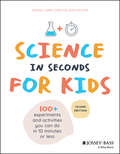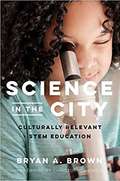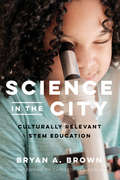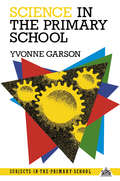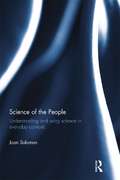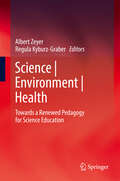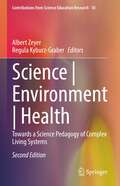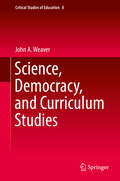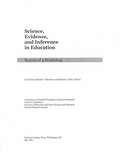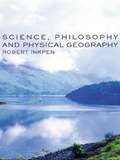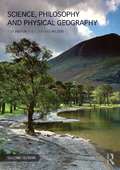- Table View
- List View
Science for Curriculum Leaders (Primary Inset Series)
by Alan Peacock Elizabeth ClaydenThe ten modules here cover both areas of particular concern in the teaching of science - organising the classroom for investigations, reviewing science coverage on a whole school basis - and the ways in which issues of more general concern in the primary curriculum (the multicultural dimension, planning for individual progression, assessment etc.), affect the teaching of science.
Science for Exercise and Sport
by David James Craig WilliamsThis handbook is written for undergraduate sport studies and sport and exercise students. It introduces students to the basic scientific principles that will underpin their learning and is aimed primarily at those who have little or no background in science. Craig Williams and David James apply key scientific concepts to real situations to better understand the principles at work. Clearly divided into three sections, the text covers: * the three physical states of gas, liquid and solid* explanations of forces, energy and electricity - including pressure, torque and joint velocity* data analysis, ICT and report writing - important areas for the scientist. Science for Exercise and Sport provides the student with all the basic scientific background information they need and demonstrates how the theory can be used to map and monitor the human body in the sport and exercise discipline.
Science for the Curious Photographer: An Introduction to the Science of Photography
by Charles S. Johnson Jr.While there are many books that teach the "how-to" of photography, Science for the Curious Photographer is a book for those who also want to understand how photography works. Beginning with an introduction to the history and science of photography, Charles S. Johnson, Jr. addresses questions about the principles of photography, such as why a camera needs a lens, how lenses work, and why modern lenses are so complicated. Addressing the complex aspects of digital photography, the book discusses color management, resolution, "noise" in images, and the limits of human perception. The creation and appreciation of art in photography is discussed from the standpoint of modern cognitive science. A crucial read for those seeking the scientific context to photographic practice, this second edition has been comprehensively updated, including discussion of DSLRs, mirror-less cameras, and a new chapter on the limits of human vision and perception.
Science in Early Childhood
by Coral Campbell Wendy Jobling Coral Campbell Wendy Jobling Christine HowittScience education in the early years is vital in assisting young children to come to know about and understand the world around them. Science in Early Childhood Education covers the theoretical underpinnings and practical applications of teaching science in early childhood settings in way that is engaging and accessible. It is a comprehensive resource for students, as well as early childhood teachers and carers, and provides up-to-date coverage of the Early Years Learning Framework. This text explores the current issues and debates in early childhood science education from an Australian perspective, whilst recognizing the links to international practice and research. A summary at the start of each chapter helps students identify the key themes and ideas in early science education, and application boxes throughout the text illustrate how theories relate to practice. Written by the experts in the field, Science in Early Childhood Education is essential reading for pre-service teachers.
Science in Early Childhood
by Coral Campbell Wendy Jobling Christine HowittScience education is crucial to young children's discovery and understanding of the world around them. This third edition of Science in Early Childhood has been substantially updated to include the most current research, bringing together an author team of respected science education researchers from across Australia. New chapters address changing priorities in early childhood science education, introducing coverage of STEM, inclusivity, Indigenous understandings of science, science in outdoor settings, intentional teaching, and reflective practice. This text complements the Australian Early Years Learning Framework and the Australian Curriculum: Science. Concepts are brought to life through detailed case studies, practical tasks and activity plans. Instructors can further supplement learning with the extensive materials located on the new companion website. Renowned for its accessible and comprehensive content, Science in Early Childhood is an essential tool for all pre-service early childhood educators.
Science in Early Childhood
by Coral Campbell Wendy JoblingScience education in the early years is vital in assisting young children to come to know about and understand the world around them. Science in Early Childhood covers the theoretical underpinnings and practical applications of teaching science in early childhood settings in way that is engaging and accessible. It is a comprehensive resource for students, as well as early childhood teachers and carers and provides up-to-date coverage of the Early Years Learning Framework. This text explores the current issues and debates in early childhood science education from an Australian perspective, whilst recognising the links to international practice and research. A summary at the start of each chapter helps students identify the key themes and ideas in early science education and application boxes throughout the text illustrate how theories relate to practice. Written by experts in the field, Science in Early Childhood is essential reading for pre-service teachers.
Science in Elementary Education: Methods, Concepts, and Inquiries
by David Stout Joseph PetersSubstantially rewritten to focus on inquiry teaching and learning as espoused in the National Science Education Standards, the new edition of Science in Elementary Education: Methods, Concepts, and Inquiries will prepare pre-service teachers to plan, facilitate, adapt, and assess inquiry experiences consistent with today’s science classroom. It accomplishes this by implementing the 6E model of inquiry teaching, addressing the planning and needs of inquiry teaching classrooms, and describing the materials teachers need to get up and running. <p><p> This practical text includes over 350 Teaching Tips throughout and Twelve Inquiry Units that model constructivist applications, build conceptual knowledge, and provide a bank of classroom-tested lessons to use in science classrooms.
Science in Seconds for Kids: Over 100 Experiments You Can Do in Ten Minutes or Less
by Jean Potter Samuel Cord StierHelp your kids explore the wonders of science with over 100 easy and accessible experiments Science in Seconds for Kids: Over 100 Experiments You Can Do in Ten Minutes or Less, 2nd Edition makes learning science with your children fun and practical. Using ingredients and components found mostly in your home or classroom, Science in Seconds for Kids instructs caregivers and educators on how to create dazzling and enlightening experiments from scratch. This book utilizes bright and colorful illustrations and diagrams throughout, making the simple experiments even more accessible. Guide your kids through experiments including: Making rainbows on the floor Popping balloons with light Bending water from a faucet Making lightning in a room Keeping paper dry underwater The experiments will fascinate youngsters of all ages and encourage a love of science and learning that could last a lifetime. Science in Seconds for Kids is perfect for elementary, traditional, and homeschool educators, as well as parents, grandparents, and other caregivers.
Science in the City: Culturally Relevant STEM Education (Race And Education Ser.)
by Christopher Emdin Bryan A. BrownScience in the City examines how language and culture matter for effective science teaching. Author Bryan A. Brown argues that, given the realities of our multilingual and multicultural society, teachers must truly understand how issues of culture intersect with the fundamental principles of learning. This book links an exploration of contemporary research on urban science teaching to a more generative instructional approach in which students develop mastery by discussing science in culturally meaningful ways. <P><P> The book starts with a trenchant analysis of the “black tax,” a double standard at work in science language and classrooms that forces students of color to appropriate and express their science knowledge solely in ways that accord with the dominant culture and knowledge regime. Because we are in an interactive, multimedia world, the author also posits the necessity of applying what is known about best practices in science teaching to best practices in technology. <P><P> The book then turns to instruction, illustrating how science education can flourish if it is connected to students’ backgrounds, identities, language, and culture. In this empowered—and inclusive—form of science classroom, the role of narrative is key: educators use stories and anecdotes to induct students into the realm of scientific thinking; introduce big ideas in easy, familiar terms; and prioritize explanation over mastery of symbolic systems. The result is a classroom that showcases how the use of more familiar, culturally relevant modes of communication can pave the way for improved science learning.
Science in the City: Culturally Relevant STEM Education (Race and Education)
by Bryan A. Brown2021 Outstanding Book Award, American Association of Colleges for Teacher Education (AACTE)Science in the City examines how language and culture matter for effective science teaching. Author Bryan A. Brown argues that, given the realities of our multilingual and multicultural society, teachers must truly understand how issues of culture intersect with the fundamental principles of learning. This book links an exploration of contemporary research on urban science teaching to a more generative instructional approach in which students develop mastery by discussing science in culturally meaningful ways. The book starts with a trenchant analysis of the &“black tax,&” a double standard at work in science language and classrooms that forces students of color to appropriate and express their science knowledge solely in ways that accord with the dominant culture and knowledge regime. Because we are in an interactive, multimedia world, the author also posits the necessity of applying what is known about best practices in science teaching to best practices in technology. The book then turns to instruction, illustrating how science education can flourish if it is connected to students&’ backgrounds, identities, language, and culture. In this empowered—and inclusive—form of science classroom, the role of narrative is key: educators use stories and anecdotes to induct students into the realm of scientific thinking; introduce big ideas in easy, familiar terms; and prioritize explanation over mastery of symbolic systems. The result is a classroom that showcases how the use of more familiar, culturally relevant modes of communication can pave the way for improved science learning.
Science in the Early Years: Building Firm Foundations from Birth to Five
by Pat Brunton Linda C ThorntonGiving early years practitioners and students the confidence to effectively support scientific exploration and investigation with young children, this book explains the science behind young children's knowledge and understanding of the world. Linking theory to good early years practice, the emphasis throughout the book is on recognizing young children as competent, creative thinkers and building on their ideas. The reader is encouraged to think carefully about the role of the adult in supporting child-initiated learning and discovery by providing open ended resources, asking productive questions and observing carefully. The authors provide essential background information for all the key areas of scientific knowledge supported by practical ideas suitable for babies, toddlers and children aged 3 to 5 years. For each of these ideas, practice and theory are linked by highlighting the skills, attitudes and dispositions to observe and the questions to ask to challenge young children's thinking and plan for the next stages in their learning. Chapters cover: - the place of science in early years curricula in the UK - the processes of science and the role of the adult in supporting young children's scientific learning - using open ended resources to create a science-rich environment - essential background knowledge, covering all areas of early years science - ideas to use as starting points for exploration and investigation, indoors and outdoors - pointers for observational assessment and planning - suppliers of resources and equipment By making clear links to practice, and providing ideas to use with babies and toddlers as well as with 3-5 year old children, this book enables the reader to fully exploit the potential for exploration and investigation in any early years setting. Pat Brunton and Linda Thornton are both Education Consultants based in Cheltenham. They run their own training and consultancy company alc associates, and edit Early Years Update.
Science in the Primary School (Subjects in the Primary School)
by Yvonne GarsonUsing practical examples and case studies the author examines some of the experimental and investigative teaching methods which are intended to support the 'specialist approach' in the teaching of primary science.
Science of Nutrition: Passbooks Study Guide (Excelsior/Regents College Examination Series)
by National Learning CorporationThe Excelsior/Regents College Examinations (E/RCE) offer you an opportunity to obtain recognition for college-level learning and consists of exams designed to demonstrate achievement and mastery of various college-level subjects, such as the Arts and Sciences, Business, Criminal Justice, Education, Health and Nursing. The E/RCE Science of Nutrition Passbook® prepares you by sharpening knowledge of the skills and concepts necessary to succeed on the upcoming exam and the college courses that follow. It provides a series of informational texts as well as hundreds of questions and answers in the areas that will likely be covered on your upcoming exam.
Science of the People: Understanding and using science in everyday contexts
by Joan SolomonHow do people understand science? How do they feel about science, how do they relate to it, what do they hope from it and what do they fear about it? Science of the People: Understanding and using science in everyday contexts helps answer these questions as the result of painstaking interviewing by Professor Joan Solomon of all and sundry in a fairly typical small town. The result is a unique overview of how a very wide range of adults, united only by local geography, relate to science. Many of the findings run contrary to what is widely believed about how science is learnt and about how people view it. Chapters include: An Approach to Awareness Publics for Science? Ethics and Action Interpretation and Change Joan Solomon, who sadly died before this book could be published, enjoyed an international reputation in science education. After a long career teaching science in secondary schools she moved into the university sector and ending up holding chairs of science education at the Open University, King’s College London and the University of Plymouth. She was a world leader in her subject and inspired classroom teachers and wrote a number of very influential papers with some of them. She produced many important books, booklets and other resources to help science teachers and science educators get to grips with the history and philosophy of science and the teaching of energy, amongst other topics. This book is essential reading for those involved in Science education and educational policy.
Science | Environment | Health: Towards a Renewed Pedagogy for Science Education (Contemporary Trends and Issues in Science Education)
by Albert Zeyer Regula Kyburz-GraberHealth and the environment are important learning areas in science education and their significance is growing. Not only do they have high social relevance, but they are also close to students' interests and needs. They provide many opportunities to unlock science with questions that are personally relevant to boys and girls and that inspire them to engage in science. This book contains a selection of papers from prominent professionals in science, health and environmental education, who reflect on science education, each from their specific point of view. The core idea is to present well-founded perspectives on how science education may benefit from challenges stemming from both health and environmental education. Specific reasons are discussed as to why these two areas are particularly legitimized to challenge science education, and their potential impact on a revision of science education is evaluated. A new pedagogy for science¦environment¦health that yields interesting and relevant science education for students and teachers, and addresses the grand challenges of this century: what an attractive and rewarding project! The book will motivate teachers, teacher educators and science education researchers to take part in this on-going project.
Science | Environment | Health: Towards a Science Pedagogy of Complex Living Systems (Contributions from Science Education Research #10)
by Albert Zeyer Regula Kyburz-GraberThis book provides a fascinating insight into the on-going process of self- reflection in the Science|Environment|Health (S|E|H) community. The basic vision of a new S|E|H pedagogy is to establish a transdisciplinary dialogue between the three educational fields of science education, environmental education, and health education. This approach finds growing interest among science educators. Since 2014, the ESERA special interest group S|E|H has united both experienced and junior researchers all over Europe in a burgeoning research community.This book presents a selection of results of these vibrant activities. Systems theory has turned out to be a stimulating theoretical framework for S|E|H. The limits of predictability in complex living systems result in structural uncertainty for decision-making, and they ask for emphasising and rethinking the role of pedagogical concepts like informed citizenship and scientific literacy. They challenge crude scientific determinism in environmental and health education, which all too often ends up with students’ eco- and health depression. Instead, S|E|H conceives coping with uncertainty in terms of an interplay between cognitive and affective factors. The horizon of the future remains always open. Hope must never die in a new S|E|H pedagogy.Chapter 3 is available open access under a Creative Commons Attribution 4.0 International License via link.springer.com.
Science, Social Science class 6 - Tamil Nadu Board
by Tamil GovernmentThe Science textbook for standard six has been prepared following the guidelines given in the National Curriculum Framework 2005. The book is designed to maintain the paradigm shift from the primary General Science to branches as Physics, Chemistry, Botany and Zoology.
Science, Business and Universities: Cooperation, Knowledge Transfer and Entrepreneurship (Routledge Studies in International Business and the World Economy)
by Joanna Duda Tomasz BernatCooperation between science and business (S2B cooperation) is a very important issue from the points of view of the domestic economy, companies, and universities. This is mainly because such cooperation is a catalyst for faster and reliable development – not only of enterprises, but also of the entire economy. Thanks to S2B cooperation, enterprises can gain and commercialize new and ground-breaking solutions. Universities in turn can give their research a more practical dimension to increase its economic applicability, which helps universities prepare future staff to work in modern enterprises. The aim of this publication is to indicate how cooperation between universities and business can be implemented in an international dimension. It shows the role of modern universities in supporting the development of enterprise and entire economies as well as the role of modern enterprises that use resources located in universities (including knowledge resources). This unique combination has a positive impact on the results and developmental opportunities for each of them. Any potential obtained in this manner is the basis for creating a competitive advantage on the market. This book is devoted to a specific area of cooperation between enterprises and universities and will be of interest to researchers, academics, practitioners, and students in the fields of entrepreneurship, knowledge management, international relations, and higher education.
Science, Democracy, and Curriculum Studies (Critical Studies of Education #8)
by John A. WeaverIn this book John A. Weaver suggests curriculum studies scholars need to engage more in science matters. It offers a review of science studies writing from Ludwick Fleck and Thomas Kuhn to Philip Mirowski. The volume includes chapters on the rhetoric of science with a focus on the history of rhetoric and economics then on the rhetoric of models, statistics, and data, a critique of neoliberalism and its impact on science policy and the foundations of democracy, Harry Collin’s and Robert Evans’ theory of expertise followed by chapters on feminism with a focus on the work of Sharon Traweek, Karen Barad, and Vinciane Despret, postcolonial thought, with attention paid to the work of Daniela Bleichmar, Londa Schiebinger, Judith Carney, Sylvia Wynter, Paul Gilroy, and Sandra Harding, and a final chapter on Nietzsche’s philosophy of science. Each section is introduced by an interlude drawing on autobiographical connections between curriculum studies and science studies.
Science, Evidence, and Inference in Education: Report of a Workshop
by Committee on Scientific Principles in Education ResearchThe National Academies Press (NAP)--publisher for the National Academies--publishes more than 200 books a year offering the most authoritative views, definitive information, and groundbreaking recommendations on a wide range of topics in science, engineering, and health. Our books are unique in that they are authored by the nation's leading experts in every scientific field.
Science, Philosophy and Physical Geography
by Robert Inkpen Graham WilsonThis accessible and engaging text explores the relationship between philosophy, science and physical geography. It addresses an imbalance that exists in opinion, teaching and to a lesser extent research, between a philosophically enriched human geography and a perceived philosophically ignorant physical geography.Science, Philosophy and Physical Geography, challenges the myth that there is a single self-evident scientific method, that can and is applied in a straightforward manner by physical geographers. It demonstrates the variety of alternative philosophical perspectives. Furthermore it emphasizes the difference that the real world geographical context and the geographer make to the study of environmental phenomenon. This includes a consideration of the dynamic relationship between human and physical geography. Finally, it demonstrates the relevance of philosophy for both an understanding of published material and for the design and implementation of studies in physical geography. Key themes such as global warming, species and evolution and fluvial geomorphology are used to provide illustrations of key concepts in each chapter. Further reading is provided at the end of each chapter.
Science, Philosophy and Physical Geography
by Robert Inkpen Graham WilsonThis accessible and engaging text explores the relationship between philosophy, science and physical geography. It addresses an imbalance that exists in opinion, teaching and to a lesser extent research, between a philosophically enriched human geography and a perceived philosophically empty physical geography. The text challenges the myth that there is a single self-evident scientific method that can, and is, applied in a straightforward manner by physical geographers. It demonstrates the variety of alternative philosophical perspectives and emphasizes the difference that the real world geographical context and the geographer make to the study of environmental phenomenon. This includes a consideration of the dynamic relationship between human and physical geography. Finally, the text demonstrates the relevance of philosophy for both an understanding of published material and for the design and implementation of studies in physical geography. This edition has been fully updated with two new chapters on field studies and modelling, as well as greater discussion of ethical issues and forms of explanation. The book explores key themes such as reconstructing environmental change, species interactions and fluvial geomorphology, and is complimented throughout with case studies to illustrate concepts.
Science, Social Science Volume 3 Term 2 class 6 - Tamil Nadu Board
by Tamil GovernmentThe Science textbook for standard six has been prepared following the guidelines given in the National Curriculum Framework 2005. The book is designed to maintain the paradigm shift from the primary General Science to branches as Physics, Chemistry, Botany and Zoology.
Science, Social Science Volume 3 Term 3 class 6 - Tamil Nadu Board
by Training State Council of Educational ResearchThe Social Science textbook for standard six of term 3 and volume 3. The book is designed to maintain the paradigm shift from the primary General Science to branches as Physics, Chemistry, Botany and Zoology.
